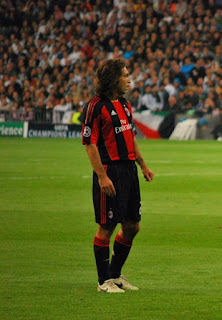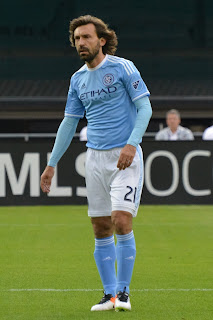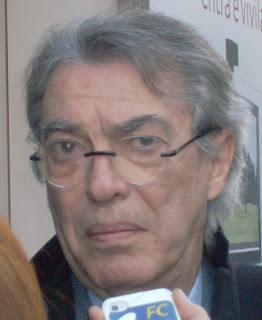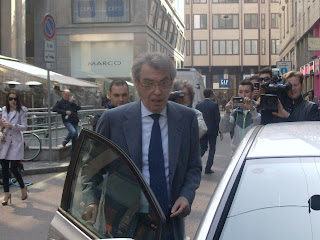The original - and best - attacking full back
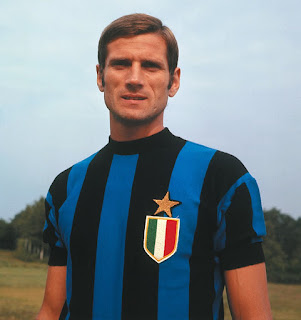 |
| Giacinto Facchetti in the famous blue and black striped shirt of the all-conquering Inter-Milan |
He had been suffering from pancreatic cancer. When his funeral took place at the Basilica di Sant’Ambrogio in Milan, more than 12,000 fans joined the mourners marking his life. His remains were then taken back to his home town of Treviglio in the province of Bergamo.
Apart from being regarded as the model professional and a pillar of moral decency, Facchetti was seen as a player ahead of his time, the first attacking full back who was a master in both disciplines of his game.
Under the coaching of Internazionale’s great Argentine-born coach, Helenio Herrera, he became integral to the defensive system known as catenaccio, of which Herrera was one of the highest profile advocates.
But Facchetti also knew exactly when to turn defence into attack and to exploit his speed and athleticism going forward. Inter were known as a defensive team but they were also one of the best at punishing opponents with rapid breakaway attacks. In more than 600 appearances for Inter, Facchetti scored 75 goals, the most by any defender in the history of football in Italy.
 |
| The Italy team that won the 1968 European Championships with Facchetti, the captain, at the back, on the far right |
Facchetti’s prowess as a goalscorer was no accident. When Herrera spotted him playing for the youth team at his local club CS Trevigliese, he was a centre forward, but Herrera knew instantly he was the kind of player he wanted at full back.
Born in 1942, Facchetti had been a bright student. He once had ambitions to become a doctor but the chance to play professional football won the day. He made his Serie A debut for Inter against Roma in May 1961, at the age of 19.
Apart from Trevigliese, Facchetti played for no other club than Inter. With the so-called ‘Grande Inter’ team of the 1960s and early ‘70s, he won the scudetto in 1963, 1965, 1966 and 1971, the European Cup in 1964 and 1965, and two Intercontinental Cups in 1964 and 1965.
 |
| Facchetti remained with Inter after his playing career ended, as a coach and then club president |
Selected for the national team for the first time in May 1963, Facchetti went on to win 94 caps, a total surpassed only by Dino Zoff, Paolo Maldini, Fabio Cannavaro and Gianluigi Buffon.
He captained the azzurri 70 times, leading them at the World Cup finals 1970 and 1974, having played at his first World Cup in England in 1966, when Italy suffered the humiliation of being beaten by North Korea.
But Italy bounced back to win the European Championships in 1968 and then took part in two of the finest World Cup matches of all time in Mexico in 1970, first defeating West Germany 4-3 after extra time in the semi-finals in front of 102,000 fans in a baking hot Azteca Stadium, with Facchetti leading by unstinting example, followed by the final in which the Brazil of Pele, Rivelino, Jairzinho and Carlos Alberto put on one of the greatest exhibitions of exhilarating attacking football ever seen to win 4-1.
Facchetti saw out his career at Inter, first on the technical staff and latterly as nominal president, effectively protecting the actual owner and besieged ex-president, Massimo Moratti.
| The Basilica of San Martino in Treviglio was originally built in 1008 |
Treviglio, where Facchetti was born, is situated about 20km (12 miles) south of Bergamo and about 40km (25 miles) east of Milan. Known as the town of courtyards, its main sights are the Palazzo Municipale, which dates back to 1300, and the Basilica of San Martino, originally built in 1008 and remade in the in Lombard-Gothic style in 1482, with a Baroque facade added in 1740. The bell tower dates to the early 11th century. The historical Bar Milano, in Piazza Manara, was founded in 1896 and still retains the original furniture of the century and a counter in Art Nouveau style.
 |
| The Basilica di Sant'Ambrogio in Milan, where 12,000 Inter fans turned out for Facchetti's funeral |
The Basilica of Sant’Ambrogio is in south west Milan in Piazza Sant’Ambrogio. It was originally built by Aurelius Ambrosius, who was a lawyer who became Bishop of Milan by popular demand, on the site of an earlier Christian burial ground. It was named after him after his remains were placed there, before being rebuilt in the 11th century and further modified in the 15th century.
More reading:
The record-breaking career of Paolo Maldini
Gianluigi Buffon's long-running success story
The brilliance of Luigi Riva
Also on this day:
The Feast Day of Saint Rosalia
1850: The birth of military leader Luigi Cadorna
Home





